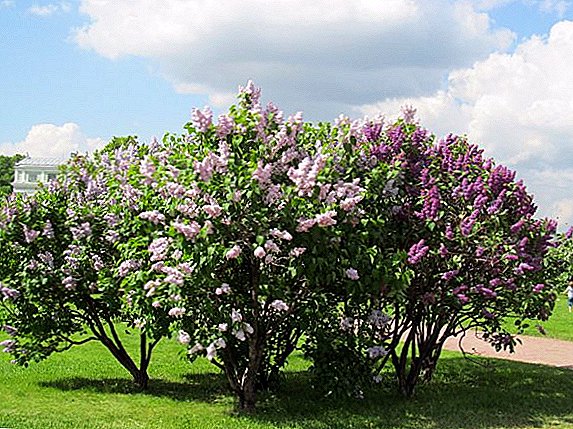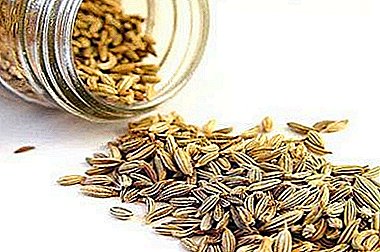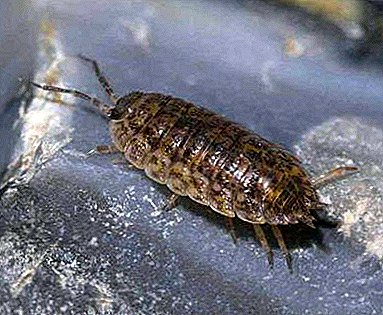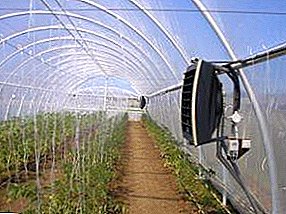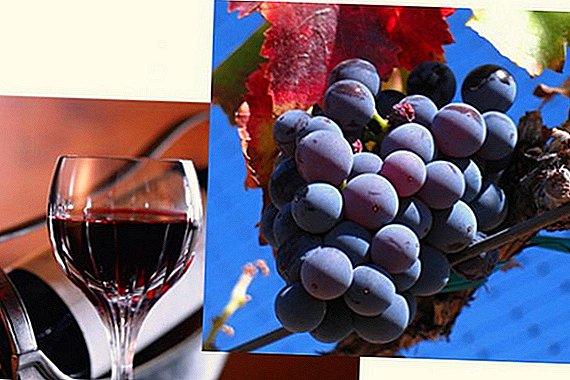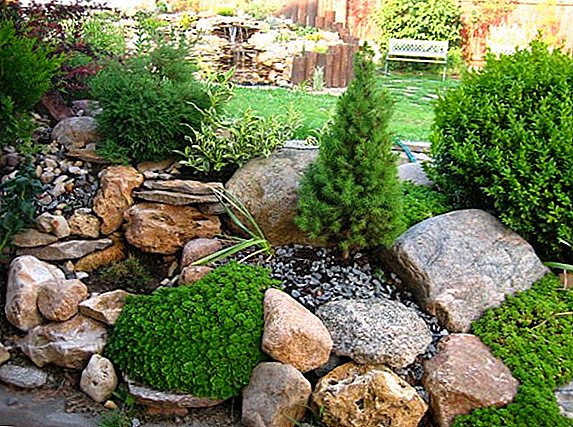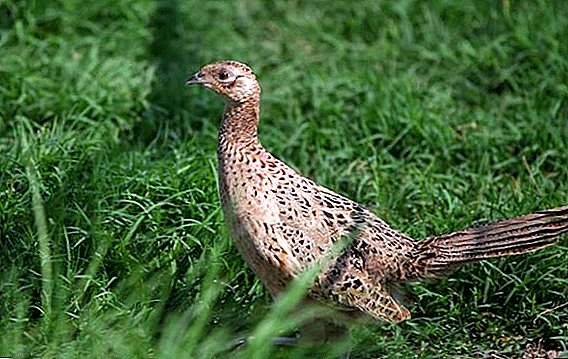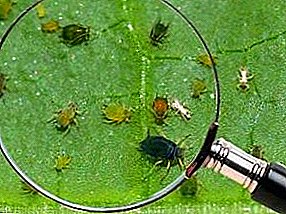 Aphid - A tiny, soft-bodied insect, one of the worst garden pests.
Aphid - A tiny, soft-bodied insect, one of the worst garden pests.
Its main trump cards in the struggle for survival are extraordinary voracity and the same extraordinary fecundity.
What eats aphids
Her favorite plants include the following:
- tuberous begonia;
- nasturtium;
- mallow;
- kosmey;
- roses
Among vegetable, greenhouse and melon crops:
- cucumbers (first of all);
- tomatoes;

- potatoes;
- salad;
- cabbage;
- eggplants;
- Bell pepper;
- watermelon melon.
Among garden crops:
- Apple tree;
- cherry;
- plum;
- viburnum, red and black currants.
What aphid is dangerous for plants?
With their proboscis insects pierce the skin of young plants and suck the juices, weakening the plants, not allowing them to grow, bear fruit and bloom.
Chlorosis is caused, that is, a disease in which the plant cannot synthesize chlorophyll in the right quantities - the outer signs of the disease are yellowed and faded leaves. In addition, aphid is a peddler of viral infections. Yeast and mold fungi actively reproduce on the sugary secretions of the aphid (honeydew).
Read on the site how to get rid of the wireworm in the garden.
The Prestige tool will help from the Colorado potato beetle, read more here.
Medvedka can spoil your harvest: //rusfermer.net/ogorod/vrediteli-ogorod/bor-ba-s-vreditelyami-vrediteli-ogorod/nasekomoe-medvedka-uznaj-i-pobedi.html
Methods of dealing with aphids
The fight against this pest should be comprehensive. Simple preventive measures will help if not completely destroy the population of pests, then significantly reduce their number and prevent reproduction.
Aphid Prevention
In the autumn, after harvesting, perennial weeds are weeded out and treated with herbicides, which often serve as a refuge for colonies of aphids.
In early spring, before planting seedlings, the greenhouse and garden tools should be treated with bleach or caustic soda. Before planting plants in open ground, you must inspect the area for weeds and get rid of them.
Like other pests, aphids feel good at high humidity and high temperatures. A good drainage system on the site will protect the garden not only from aphids, but also from other misfortunes of gardeners - slugs.
 Especially "appetizing" for aphids plants should be planted away from the beds with vegetables and greenhouses.
Especially "appetizing" for aphids plants should be planted away from the beds with vegetables and greenhouses.
Plants are less affected by aphids, if not overfed with nitrogen fertilizers. It is better to feed plants with ashes or potash-phosphorus fertilizers.
Inspect plantings regularly for insect infestations. Strongly affected branches should be cut and discarded. Sometimes it is enough to tear off or pinch off the affected tip to prevent further infection.
Spend some money on agrofibre for strawberries to collect your own strawberries in the early spring.
Features of growing strawberries in the greenhouse in winter: //rusfermer.net/ogorod/plodovye-ovoshhi/vyrashhivanie-v-teplitsah/kak-vyrashhivat-klubniku-v-teplitse.html
Mechanical means
The easiest way to get rid of aphids - just collect her hands.
The second way is to water the plants with a strong jet of water from a hose. It is preferable to do this in the morning, so that the plants have time to dry in a day.
Organic (biological) products
 The most famous aphid fighter is ladybug. Its larva per day can destroy up to 70 aphids. In total, a ladybug can destroy up to 700-800 harmful insects in its life.
The most famous aphid fighter is ladybug. Its larva per day can destroy up to 70 aphids. In total, a ladybug can destroy up to 700-800 harmful insects in its life.
It is possible to attract cows to the garden by planting fragrant herbs - parsley, dill, coriander, tansy. They also love chamomile.
In order for the cows to overwinter in the garden, and in the spring they would start breeding numerous offspring, you need to provide them with good conditions for hibernation - leave an armful of dry leaves, bark or stones somewhere in a secluded corner in late autumn.
Another enemy of the aphid is the golden-eyed or fleurge. She loves so much to feast on aphids, that her larva bears the name of the "lion lion". They are attracted by dandelions, yarrows and other umbrella plants.
For wintering the golden-eyed in September, install special houses, inside which put dry leaves, bark and straw. To attract insects there, houses are treated with special baits - attractors.
 Birds are dangerous enemies - tits, chicks, blood flakes, robins, sparrows - will be happy to eat aphids and feed the chicks with it, you just need to equip in the backyard for birds and the feeder.
Birds are dangerous enemies - tits, chicks, blood flakes, robins, sparrows - will be happy to eat aphids and feed the chicks with it, you just need to equip in the backyard for birds and the feeder.
But black garden ants feed on the pad - sweet aphids secretions, therefore they jealously protect their “herd” and spread the aphids around the plants, looking for new “pastures” for it.
Therefore, we must also fight with ants. For this, the anthill is slightly excavated and poured boiling water. The nest can be stirred and covered with lime-fluff or tobacco crumbs.
Folk remedies to combat aphids
They include spraying the affected plants with self-prepared solutions. Here are some recipes:
- Potato haulm solution: pour a bucket of warm water with 2 kg of shredded tops, leave for 3-4 h, drain.
- Yarrow infusion: 200 g of fresh grass pour 2 liters of boiling water, leave for 1 hour. Then add 8 liters of water.
- Liquid soap based solution: 2 teaspoons of liquid soap for 2 cups of water. You can add 1 cup of vegetable oil.
- Broth from onion peel: 10 liters of boiling water half a bucket of husk. Insist day, strain and spray.
- Ash-based solution: 1 kg of ash pour 8 liters of boiling water, leave under the lid for 2 days, drain.
- Just spray the plants from the spray with the cheapest vodka.
- Water with "Coca-Cola" - for 1 hour of water for 5 hours of soda (regular, not dietary). It is necessary to dilute it with water, because in its pure form a carbonated drink can burn the delicate leaves of young plants.
In order for the funds to have the greatest effect, it is necessary to spray the plants in dry, calm weather.
Features of the structure of the home smokehouse.
How to make a cellar with your own hands: //rusfermer.net/postrojki/hozyajstvennye-postrojki/vspomogatelnye-sooruzheniya/stroitelstvo-pogreba-svoimi-rukami.html
Chemicals to combat aphids
If none of the above helped, heavy artillery - insecticides - is used. Prophylactic treatment should be carried out in early spring, before bud break. Many insecticides are toxic to bees, therefore they are not used during flowering.
 Soft organic products based on pyrethrins cause the least harm to the environment, plants, beneficial insects, but because of the mild effect they will have to be used more often.
Soft organic products based on pyrethrins cause the least harm to the environment, plants, beneficial insects, but because of the mild effect they will have to be used more often.
Among such drugs are Inta-Vir, Iskra, Akarin, Detsis, Fury. They quickly decompose and do not cause addiction in aphids.
Among the powerful and proven for decades drugs - dichlorvos in aerosol cans, karbofos, as well as their analogues - "Rogor" and "Fozolon".
Remember that these chemicals are highly toxic and should be used strictly following the instructions.
Remember that strong, well-groomed, healthy trees, flowers, shrubs and vegetable crops are less vulnerable to the danger of being infected by aphids. Therefore, the main measure that must be taken to combat this pest is to carefully and regularly take care of the plants.


 Read on the site how to get rid of the wireworm in the garden.
Read on the site how to get rid of the wireworm in the garden. Spend some money on agrofibre for strawberries to collect your own strawberries in the early spring.
Spend some money on agrofibre for strawberries to collect your own strawberries in the early spring. Features of the structure of the home smokehouse.
Features of the structure of the home smokehouse.